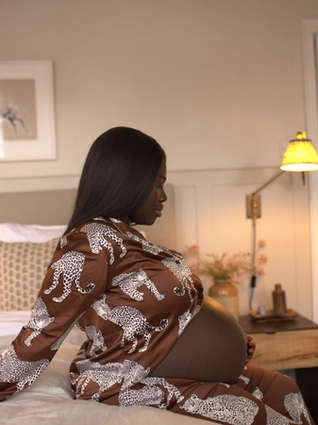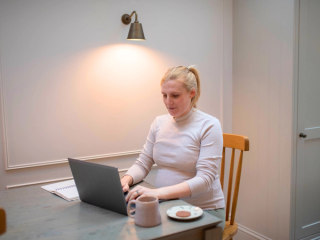
- Home
- Advice Hub
- Pregnancy
- Preparing For Arrival
- Colostrum Harvesting
Colostrum Harvesting
Learn about harvesting colostrum, its benefits for newborns, and how to safely express and store this nutrient-rich first milk during late pregnancy.
As well as growing a baby, your amazing body is making all sorts of changes in preparation for feeding your new addition once they are finally in your arms. From as early as 16 weeks of pregnancy, your milk production system is already setting the wheels in motion for a smooth transition from nurturing your baby on the inside to continued growth and development on the outside.
The duration of pregnancy varies greatly from woman to woman and all that we can predict is that, under normal circumstances, babies will arrive between 37 and 42 weeks gestation. Nature has been very clever in recognising that having large quantities of milk ready and waiting from 37 weeks could cause some very significant problems for mum should baby not arrive until 42 weeks. Mums would find themselves very sore, very uncomfortable and probably very poorly as their breasts became infected due to being full of unused milk.
What is Colostrum?
Colostrum is the first stage of breast milk our bodies produce in preparation for the arrival of our baby. Full of white blood cells, this liquid gold helps to guard and fight against infection by producing antibodies that neutralise any bugs your baby may meet in the first few months after birth. Not only that, but colostrum is packed with vitamins and minerals that are great for development of baby’s healthy skin, vision, and immune system. Colostrum may leak from your breasts during pregnancy, sometimes when experiencing a change in your emotional state or when in the shower. Sometimes there can be no obvious trigger for colostrum leaking, and this is normal.
Because all this goodness is so concentrated, your body can accommodate it for much longer without becoming uncomfortable or unwell. Just some of the benefits of colostrum include:
- Protecting your baby against disease
- Helping develop your baby’s immune system and healthy gut
- Helping your baby clear their first stool from their body
What is Colostrum Harvesting?
In recent years midwives and doctors have started to recognise the benefits of collecting small quantities of this richly packed first milk and storing it for later use. Initially, this practice of hand expressing into small sterile syringes was only recommended for women with diabetes or risk of preterm birth, but it is now recognised that it is beneficial for all mums and babies.
What are the benefits of colostrum harvesting?
There are lots of benefits for both you and your baby when considering if you should harvest your colostrum. Spending a few minutes each day from 37 weeks harvesting your baby’s first milk can help you become familiar with how your breasts feel and get you used to hand expressing.
Having some frozen colostrum can be useful if your baby is a little reluctant to feed or you are struggling with your baby’s latch. Knowing you have some pre-collected milk can be a comfort during those early days postpartum. Additionally, having a little bit of colostrum in your freezer can reassure you that your baby is getting all they need if they have particularly hungry days.
When to start harvesting colostrum?
If you are wondering ‘How much colostrum should I harvest before birth?’, there is no right answer to this, as every pregnancy is different. You can start colostrum harvesting from 36-37 weeks. There is no minimum or maximum amount - anything from a few drops to a teaspoon is normal.
If any of the following apply to you, do not express colostrum
- A history of threatened or actual premature labour.
- A cervical suture (stitch) in place.
- A medical condition requiring medication that could be harmful to your baby through breast milk.
- Placenta praevia, placenta accreta, placenta percreta, an unidentified placental site on ultrasound, vasa praevia, or a low-lying placenta.
There may be additional reasons why expressing colostrum may not be suitable for you. It is important to discuss this with your midwife before you start to express colostrum. Additionally, your midwife may be able to provide colostrum syringes to get started with.
How to start colostrum harvesting?
Aim to express colostrum once or twice a day. You can build up to expressing colostrum up to 8 times a day, if you choose. Expressing sessions should last around 5-10 minutes per breast, depending on your comfort level and how much colostrum you can express. Avoid over-expressing, as excessive stimulation can lead to discomfort or, in rare cases, mild uterine contractions. Remember to do what feels comfortable to you.
You can start colostrum harvesting from 36-37 weeks, storing your expressed colostrum in the syringe inside a fresh storage bag in the freezer. Here is our step-by-step guide for how to harvest colostrum:
- Ask your midwife for some colostrum harvesting syringes or you can purchase them online. You can’t really over collect your colostrum, but we would recommend buying 10 syringes to get you started.
- Stay relaxed. Find the right space and time where you won’t be disturbed. Just before bed is perfect.
- Gently massage your breast in a slow but firm action from the top downwards. You can have your hand either in a fist or open.
- Imagine your breast is a clock. With clean hands cup your beast with one hand and make a c-shape with your other hand. The thumb should be placed at the 12 o’clock position and the middle or index finger at 6 o’clock, forming a C-shape around the areola.
- Now gently squeeze and release the breast tissue, being careful not to pull the breast.
- Hopefully you will start to see a small amount of fluid leaking from the nipple which you or your partner can draw into the syringe by pulling back on the plunger.
- You may not get anything on your first few attempts but keep trying and don’t be disheartened if you don’t manage to collect anything. It is not an indicator of your future milk supply.
- Once you have collected some colostrum this can be dated and labelled before popping into the freezer for later use. Colostrum can be stored in the fridge for up to 48 hours so you can harvest more colostrum in the same syringe. Just make sure you freeze it before 48 hours after the first colostrum harvesting.
Storing colostrum
Keeping your hard-earned gains is really easy. All you need is a clean Tupperware or freezer bag. Once you are ready to freeze your colostrum, pop the syringe back in the sterile packet it came in and put it in your container.
You may not fill up a whole syringe on your first go so you can keep it in the fridge (-2-4 degrees) for up to 48 hours and keep topping it up. Then you can transfer it to the freezer where it can stay safely for up to 6 months.
HiPP mum Emma shares her story: ‘Harvesting colostrum was great for me as my first baby had jaundice and my second had trouble feeding on the first day, so it felt great to know that they were getting all the nutrients they needed. My hospital gave me a bunch of tiny sterile syringes and I had to express. I found after a bath was easiest.’
Faye had a similar experience. “I ended up needing the colostrum I had harvested when my baby wasn’t feeding. A family member brought it into hospital in a cool bag with ice blocks.”
Should mothers with diabetes harvest colostrum?
Expressing colostrum is recommended for all pregnancies including those who have pre-existing diabetes or develop diabetes during pregnancy (gestational diabetes).
Expressing colostrum can be particularly beneficial as babies born to diabetic mothers can experience low blood sugar levels after birth. However, it’s essential to discuss colostrum harvesting with your midwife, as diabetes can sometimes complicate pregnancy.
Final thoughts
Colostrum harvesting is a great way to prepare for your baby’s arrival, can help with your future breastfeeding experience and provide all the nourishment your baby needs.
If you’re unsure about where to begin or have some challenges with expressing colostrum, your midwife or a lactation consultant can provide further advice and support.
FAQs on harvesting colostrum
Colostrum can be kept out at room temperature for up to 4 hours. In the fridge (kept at 2-4 degrees), it can last up to 48 hours and up to 6 months kept in the freezer.
It is unlikely to trigger labour, but if while expressing you have any painful contractions, you should stop expressing immediately and call your midwife.
Label your syringe with your name and the date it was expressed. Place the syringe in a freezer bag or freezer-safe container. Remember that defrosted milk cannot be refrozen.
Lots of pregnant women find themselves struggling to harvest colostrum. It’s suggested to try and hand express at more regular periods, when feeling relaxed and calm. Warming the breast tissue can also help, such as after a warm shower or bath. Anything from a few drops to a teaspoon is normal. This small amount is perfect for your new baby because it is very concentrated and packed with protective nutrients.


